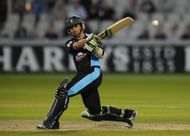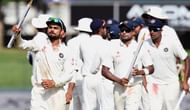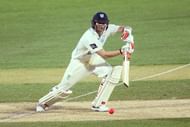In 1937, we witnessed possibly the most tactical Test match ever, between Sir Gubby Allen’s England and Sir Don Bradman’s Australia. Both captains were trying to outmanoeuvre each other with unexpected declarations, and there was an unprecedented reversing of the batting order by Bradman in the second innings to protect his batsmen from a difficult pitch.There have been a lot of other innovations by captains — Martin Crowe throwing the ball to a spinner to open the innings in the ‘92 World Cup, Mark Greatbatch’s pinch hitting in the same World Cup, the Sri Lankan openers’ blitzkrieg in the first 15 overs in the ‘96 World Cup, Australia fielding 9 slips in a Test against New Zealand in 1977, and again in an ODI against Zimbabwe in 1999.Even if nothing as radical as some of the above strategies were used in 2015, there were some innovative tactics that came into play. Let’s take a look at some of them.
#1 Brendon McCullum\'s ODI slips

Brendon McCullum’s aggressive captaincy is undoubtedly one of the stories of the past year. Though he has been too attacking for his own good at times, his all-out attack style of captaincy worked a treat for the most part.
The wonderful thing about McCullum’s captaincy in the one-dayers was his use of the slip cordon. With high-quality swing bowlers like Trent Boult and Tim Southee at his disposal, it made sense to have a lot of men behind the wicket.
New Zealand often had 3 or 4 slips and 1 or 2 gullies waiting to pounce on edges. In addition, there were often men close-in in front of the wicket. This was classic Test match field placement in ODIs, in almost every match. Even in the World Cup semi-final against South Africa, Boult and Southee bowled to 4 slips and a gully.
In another match in the World Cup, against Scotland, McCullum took it a step further. Boult was given a scarcely believable 5 slips and a gully at one point, something which would be considered outrageously attacking even in Test cricket.
And even more stunningly, McCullum continued to retain his slip fielders during the middle-overs, when the field is traditionally more spread-out.
#2 NZ finishing strike bowlers\' quota of overs early

In ODIs, captains give their opening bowlers maybe 6 overs at the start so that they can bring them back in the late middle overs or at the death.
Not McCullum. In the World Cup group match against trans-Tasman rivals and co-hosts Australia, McCullum did what many captains would consider crazy. By the 26th over, two of his bowlers Boult and Vettori had completed their quota of 10 overs, Boult taking 5/27. By the end of the 30th over, a third bowler, Southee had only one over left!
So New Zealand were left to bowl the last 20 overs with their lesser bowlers, Adam Milne, Corey Anderson and Grant Elliott, a dangerous proposition. But thanks to the wickets that the strike bowlers had taken earlier, they had to bowl only 14 balls of the last 20 overs, as Australia were all out for 145 in 32.2 overs.
If a couple of batsmen had seen out the first 30 overs, Australia would have fancied themselves to get quite a few runs against the likes of Elliot and Anderson.
McCullum’s risk paid off, but only just, as New Zealand scraped through to win by 1 run, surviving some deadly bowling from Mitchell Starc at the end.
#3 Fielding without a wicketkeeper

What do you do as captain when the batsmen are looking to hit the ball all around the ground? Wish you could sneak an extra fielder onto the park? Or simply find some way to legally get an extra fielder in?
Worcestershire captain Daryl Mitchell managed just that in the NatWest T20 Blast match against Northamptonshire. With Northants requiring 67 off the last 5 overs and a spinner bowling, Mitchell told the keeper Ben Cox to take off his gloves and pads and move back to the edge of the circle.
The umpires, who agreed after discussion that this was within the Laws, allowed play to continue without a wicketkeeper.
And it worked out well for Mitchell, as Worcestershire eventually won the match, and conceded only one bye without the keeper. One of the batsmen, Josh Cobb, however, felt that it was against the spirit of the game even if it was within the laws.
This idea to play without a wicketkeeper came from Steve Rhodes, the Worcestershire director of cricket and ex-wicketkeeper, after he saw MS Dhoni standing back to the spinners for India in 2014 (but with pads and gloves on), because the Indian skipper wanted an extra catcher.
There have been a couple of instances where teams have fielded without a keeper, including an ODI match between England and the West Indies in 1979. This was when master tactician Mike Brearley put all his fielders, including the wicketkeeper David Bairstow on the fence to prevent the opposition scoring a boundary.
This actually led to fielding restrictions becoming mandatory in limited overs international cricket.
Will we see the teams play without a wicketkeeper in the future? Maybe, especially in matches where the batting side needs to get a lot of runs on a flat pitch.
#4 India\'s 5-bowler strategy in Tests

The year 2015 was Virat Kohli’s first as permanent Test captain, as MS Dhoni retired from the longest format after the last Test of 2014.
A refreshing aspect of Kohli’s captaincy has been his readiness to play five specialist bowlers which meant having just five specialist batsmen apart from the wicketkeeper. As Kohli has always insisted, it is the bowlers who win you matches by taking 20 wickets. So the presence of an extra bowler, he reasoned, would be worth the sacrifice of a specialist batsman at Number 6.
This is not totally unexpected coming from Kohli, as he often played an extra bowler while captaining the Royal Challengers Bangalore in the IPL. This made sense in the T20 format as he had 3 world-class T20 players in the top six in Gayle, de Villiers and himself, and there was a maximum of only 20 overs.
But taking this strategy to Test level required guts, especially considering India’s batsmen haven’t always been reliable in the past.
In a total of 4 Tests – 1 against Bangladesh, 2 against Sri Lanka, and 1 against South Africa, Kohli went with the five-bowler strategy, and it resulted in two wins, a draw and a loss. Of course, one reason why Kohli could afford to play just 5 specialist batsmen was because he could depend on Numbers 7 and 8 to bat a bit: Ashwin, Jadeja, Binny, Harbhajan and the much-improved Mishra have all played at some point in these positions over the past year, and could be relied on for some useful runs.
We will no doubt see a lot more of the 5-bowler strategy from India in the future, especially on flat pitches (of which there are many), where getting 20 wickets is much more difficult than scoring runs.
#5 Cook puts Root at Short third slip

Alastair Cook has been known in past years for his unimaginative captaincy. So one doesn’t really expect him to do anything very innovative. But he did just that, as he set funky fields, made perfect bowling changes, and even invented a new fielding position!
Slip fielders often go a couple of steps forward or back to adjust for the bounce. But what happened in the first Ashes Test at Cardiff was different. After seeing several edges fall short of the regulation third slip, Cook asked Joe Root to put on a helmet and move a few yards forward, into what can be called a short third slip.
This fielding position was an indicator of Cook’s amazing transformation — from the most criticized captain in 2014 to one of the most (unexpectedly) creative captains of 2015.
#6 An early Pink ball declaration

This was the year of the first ever day-night Test match: between Australia and New Zealand, played with a pink Kookaburra ball. Now the pink ball behaves strangely under lights it moves a lot more than it does during the daytime. This obviously makes batting at night much more difficult than during the first two sessions.
Aussie captain Steven Smith clearly understood this when he was leading a very strong New South Wales side in a day-night Sheffield Shield match against South Australia. Having seen the second new ball move around prodigiously when his team was batting under lights on the first day, he decided to declare at 262/9 so that his bowlers would get a chance to bowl in these conditions. His plan worked wonderfully, with South Australia reduced to 3/3 by Mitchell Starc.
In future day-night Test/First class matches, we are sure to see more early declarations as captains generally believe its worth sacrificing an extra 15 runs to get a few wickets by making the opposition bat in tough conditions.
Brand-new app in a brand-new avatar! Download CricRocket for fast cricket scores, rocket flicks, super notifications and much more! 🚀☄️
